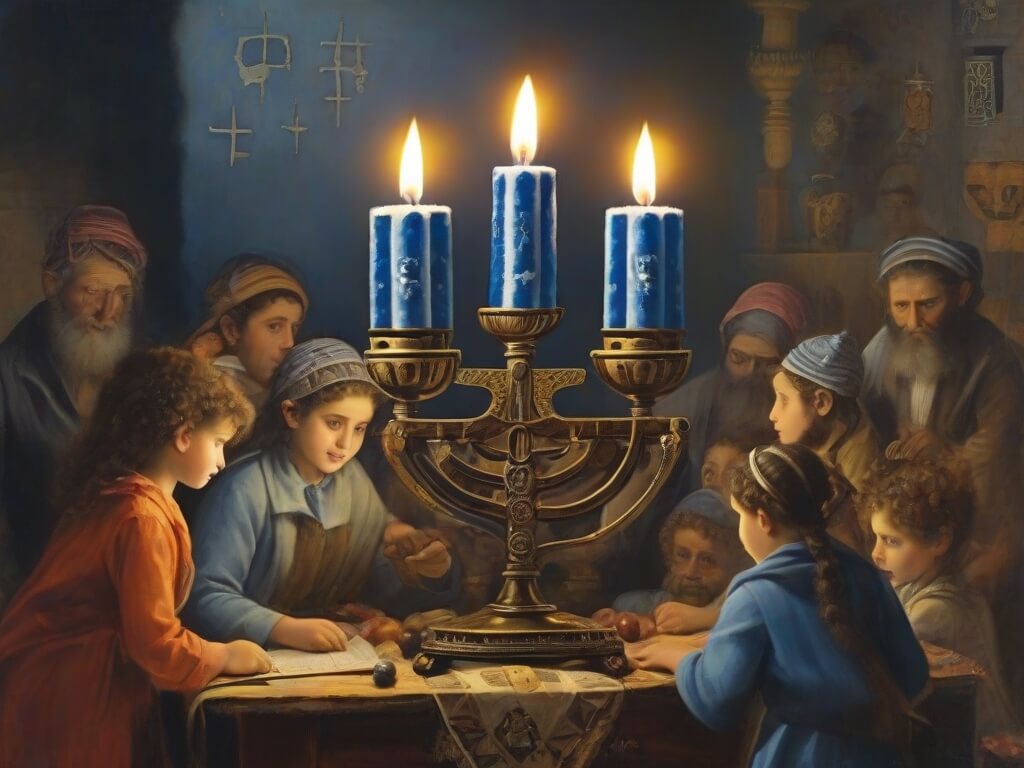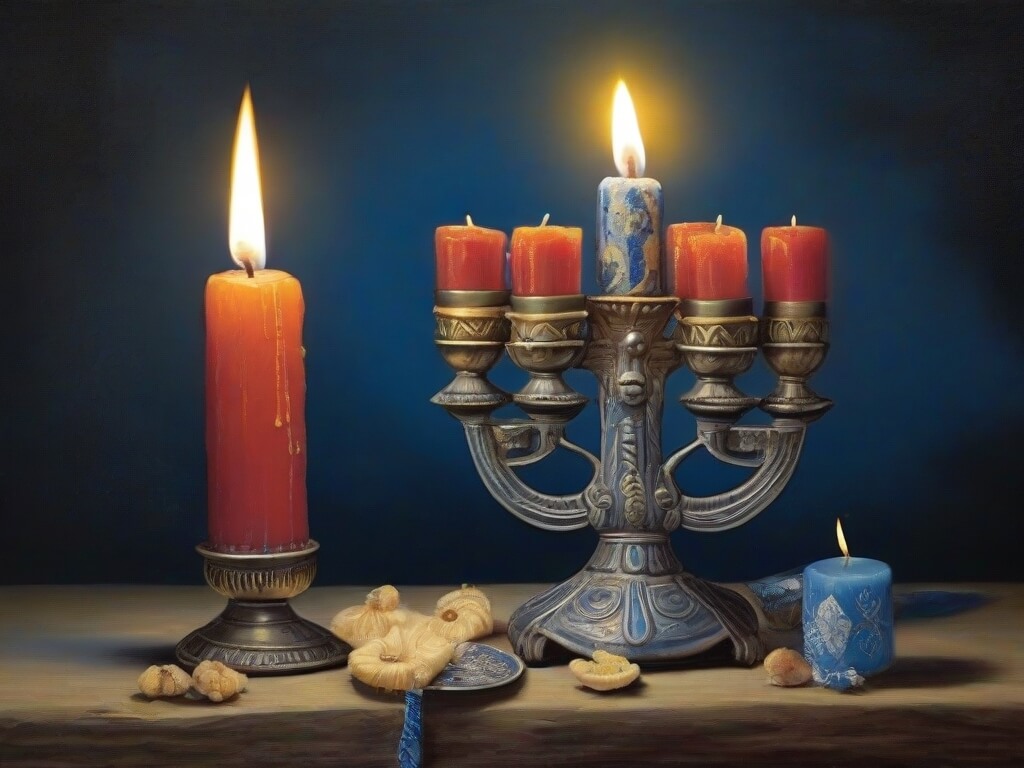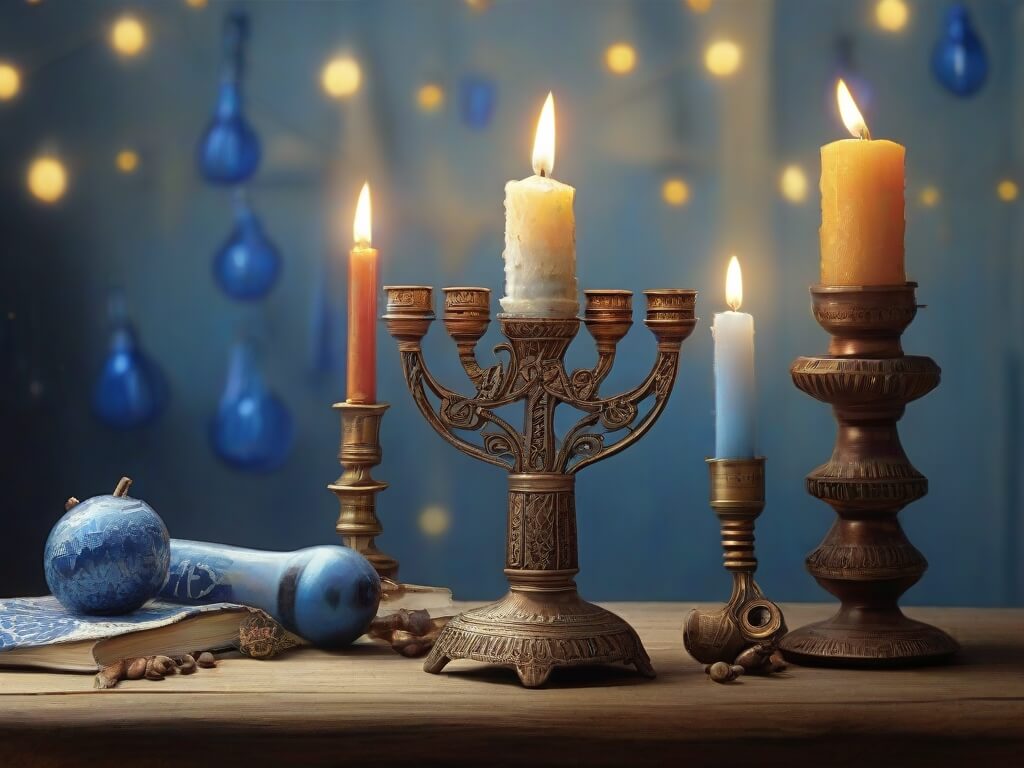Explore the traditions and activities of Hanukkah, learn when the festival takes place, and uncover the reasons why people love this joyous celebration of miracles, light, and togetherness.

Hanukkah, also spelled Chanukah, is an eight-day Jewish festival that usually falls in December. The festival is also known as the Festival of Lights. Hanukkah commemorates the rededication of the Second Temple in Jerusalem during the second century BCE.
The story of Hanukkah is rooted in historical events. In the second century BCE, the Seleucid King Antiochus IV attempted to force Hellenization upon the Jewish people, prohibiting the practice of Judaism. A group of Jewish rebels, known as the Maccabees, fought against this oppression. Eventually, they were successful in reclaiming the Holy Temple in Jerusalem, which had been desecrated by the Greeks.
The miracle associated with Hanukkah is the story of the oil. When the Maccabees rededicated the Temple, they found only a small amount of ritually pure oil, enough to light the menorah (a seven-branched candelabrum) for one day. However, the oil miraculously lasted for eight days, allowing them to keep the menorah lit until new pure oil could be obtained. This event is celebrated by lighting the Hanukkah menorah, adding one candle for each night until all eight are lit.
Other customs and traditions associated with Hanukkah include playing a game with a spinning top called a dreidel, eating foods fried in oil (like latkes, which are potato pancakes, and sufganiyot, which are jelly-filled doughnuts), and giving and receiving gifts. Families and communities come together to celebrate the festival, and the lighting of the Hanukkah candles is a central and symbolic ritual during this joyous occasion.
WHEN IS HANUKKAH?
Hanukkah is a Jewish festival that typically falls in December, but the exact dates vary each year because the Jewish calendar is lunar-based. Hanukkah begins on the 25th day of the Hebrew month of Kislev and lasts for eight nights. In the Gregorian calendar (the standard calendar used by most of the world), the dates of Hanukkah change from year to year.
To find the specific dates of Hanukkah for a particular year, it’s best to consult a Jewish calendar or an online calendar converter that provides both the Gregorian and Hebrew dates. The celebration usually begins in late November or December. Keep in mind that the exact dates may vary, so it’s always a good idea to check a reliable calendar or ask a local Jewish community for the specific dates in any given year.

HANUKKAH HISTORY
Hanukkah, also known as Chanukah, commemorates the historical events that took place in the second century BCE. The story revolves around the struggle of the Jewish people against religious oppression and the miracle associated with the rededication of the Second Temple in Jerusalem.
The historical background of Hanukkah is rooted in the Seleucid rule of Judea during the time of the Second Temple. Antiochus IV, a Seleucid king, attempted to impose Hellenization on the Jewish population. He outlawed Jewish practices, desecrated the Temple, and placed a statue of Zeus in the Holy of Holies.
A group of Jewish rebels, led by Judah Maccabee and his brothers, rose against the Seleucid forces in what became known as the Maccabean Revolt. Despite being significantly outnumbered, the Maccabees successfully reclaimed the Temple in 165 BCE and sought to rededicate it.
The miracle associated with Hanukkah is the story of the oil. According to tradition, when the Maccabees rededicated the Temple, they found only a small amount of ritually pure oil that could be used to light the menorah. This oil was enough for only one day, but miraculously it lasted for eight days until new pure oil could be obtained. This event is symbolized by the lighting of the Hanukkah menorah, a candleholder with eight branches.
Hanukkah is observed by lighting one candle on the menorah for each night of the festival until all eight candles are lit. Another candle, called the shamash (servant), is used to light the others. This ceremony takes place after sundown, and families often recite prayers and sing songs during the candle-lighting ritual.
In addition to lighting the menorah, other customs associated with Hanukkah include playing with a spinning top called a dreidel, eating foods fried in oil, such as latkes (potato pancakes) and sufganiyot (jelly-filled doughnuts), and giving and receiving gifts. The festival is a time for joy, celebration, and the remembrance of historical events that highlight the resilience and determination of the Jewish people.
HANUKKAH SCHEDULE
The schedule for Hanukkah can vary each year because the Jewish calendar is based on the lunar cycle. Hanukkah begins on the 25th day of the Hebrew month of Kislev and lasts for eight nights, typically falling in December on the Gregorian calendar. Below is a general guide to the schedule of Hanukkah:
- Dates: Hanukkah starts at sundown on the 25th day of Kislev and continues for eight nights. It can start as early as late November or as late as late December.
- Candle-Lighting: The central ritual of Hanukkah is the lighting of the menorah (a nine-branched candelabrum). On the first night, one candle is lit, and an additional candle is lit on each successive night until all eight candles, representing the eight nights of the miracle, are illuminated. The ninth candle, called the shamash (servant), is used to light the others.
- Prayers and Songs: Families often gather for prayers and the singing of traditional Hanukkah songs during the candle-lighting ceremony. There are specific blessings (brachot) recited when lighting the candles.
- Traditional Foods: Hanukkah is also a time for special foods, particularly those fried in oil to commemorate the miracle of the oil. Latkes (potato pancakes) and sufganiyot (jelly-filled doughnuts) are commonly enjoyed.
- Dreidel Game: The spinning top game known as dreidel is a traditional Hanukkah activity. The dreidel has four Hebrew letters, which stand for the phrase “Nes Gadol Haya Sham” meaning “A Great Miracle Happened There.”
- Gift-Giving: Gift-giving is a common custom during Hanukkah. While not as central as in some other winter holidays, it has become a popular way for families to celebrate and share joy.
For the specific dates and times of Hanukkah in any given year, it’s advisable to consult a Jewish calendar, community announcements, or online resources that provide both the Gregorian and Hebrew dates. The schedule may vary, so it’s always a good idea to verify the information for the current year.

HANUKKAH TRADITIONS
Hanukkah, also known as Chanukah, is an eight-day Jewish festival that usually falls in December. It commemorates the rededication of the Second Temple in Jerusalem during the second century BCE. The central theme of Hanukkah is the miracle of the oil, where a small amount of oil miraculously lasted for eight days, allowing the menorah in the Temple to stay lit.
Here are some of the key traditions associated with Hanukkah:
- Lighting the Menorah (Hanukkiah): One of the most well-known traditions is the lighting of the Hanukkah menorah, also called a Hanukkiah. It has nine branches, with one candle lit on each night of the festival. The ninth candle, the “shamash” or “helper,” is used to light the other candles.
- Reciting Blessings (Blessings for the Candles – “Blessing over the Candles”): When lighting the candles, there are specific blessings that are recited. The first two blessings are said on the first night, and the third blessing is recited each night.
- Playing Dreidel: Dreidel is a spinning top with Hebrew letters on each side. The letters stand for “Nes Gadol Haya Sham,” which means “A great miracle happened there.” It’s a traditional game played with a pot of chocolate coins (gelt) or other small treats.
- Eating Fried Foods: Because the miracle of Hanukkah involves oil, many traditional Hanukkah foods are fried. Potato latkes (pancakes) and sufganiyot (jelly-filled doughnuts) are popular choices.
- Giving and Receiving Gifts: While not a strictly traditional part of Hanukkah, the custom of giving and receiving gifts has become more widespread, especially in regions influenced by Christmas traditions.
- Hanukkah Songs: There are several traditional songs associated with Hanukkah, such as “Ma’oz Tzur” (Rock of Ages) and “Hanukkah, Oh Hanukkah.” Singing these songs is a way to celebrate and create a festive atmosphere.
- Reading the Hanukkah Story: Families often read and discuss the historical events and significance of Hanukkah, emphasizing the bravery of the Maccabees and the miraculous nature of the oil.
- Charitable Acts: Hanukkah is also a time for giving to those in need. Some families engage in charitable activities, such as donating to a food bank or participating in community service.
These traditions vary among Jewish communities, and families may incorporate their own customs into the celebration of Hanukkah. The festival is a time for joy, reflection, and the celebration of Jewish identity and resilience.
HANUKKAH FREQUENTLY ASKED QUESTIONS
Here are some frequently asked questions (FAQs) about Hanukkah along with brief answers:
- What is Hanukkah?
- Hanukkah, also known as Chanukah, is an eight-day Jewish festival that commemorates the rededication of the Second Temple in Jerusalem. It is celebrated with the lighting of the menorah, playing dreidel, and enjoying festive foods.
- When is Hanukkah celebrated?
- Hanukkah begins on the 25th day of the Jewish month of Kislev, which usually falls in December. The date is based on the Hebrew calendar, so it varies each year in the Gregorian calendar.
- Why is Hanukkah celebrated for eight days?
- The celebration lasts for eight days to commemorate the miracle of the oil. According to tradition, a small amount of oil miraculously lasted for eight days, allowing the menorah in the rededicated Temple to stay lit.
- What is the significance of the Hanukkah menorah?
- The Hanukkah menorah, also called a Hanukkiah, has eight branches, each representing one night of Hanukkah. The ninth branch, the shamash (helper), is used to light the other candles.
- What are traditional Hanukkah foods?
- Traditional Hanukkah foods include potato latkes (pancakes), sufganiyot (jelly-filled doughnuts), gelt (chocolate coins), and foods fried in oil to symbolize the miracle of the oil.
- What is the story of Hanukkah?
- The Hanukkah story involves the Maccabees, a group of Jewish rebels who successfully revolted against the Seleucid king Antiochus IV. After reclaiming the Temple, they found only enough oil to light the menorah for one day, but it miraculously lasted for eight days.
- Is Hanukkah a major Jewish holiday?
- While not one of the biblically mandated festivals, Hanukkah has become a widely celebrated and culturally significant holiday, especially in regions with a significant Jewish population.
- Are gifts exchanged during Hanukkah?
- Gift-giving has become a common custom during Hanukkah, especially in places where the holiday coincides with the Christmas season. Children often receive small gifts or gelt during the celebration.
- What is the significance of the dreidel?
- The dreidel is a spinning top with Hebrew letters on each side. It is used in a traditional Hanukkah game, and the letters stand for “A great miracle happened there” (in Israel, “here”).
- How is Hanukkah observed in different Jewish denominations?
- Different Jewish denominations may have variations in how they observe Hanukkah, but the central themes of lighting the menorah, playing dreidel, and celebrating the miracle of the oil are common across denominations.
These are general answers, and there can be additional variations and details depending on individual customs and traditions within the diverse Jewish community.
HANUKKAH ACTIVITIES
Hanukkah, being a festive and joyous occasion, is often marked by various activities that bring families and communities together. Here are some Hanukkah activities you might consider:
- Lighting the Menorah:
- This is the central and most symbolic activity of Hanukkah. Each night, a candle is added to the menorah, starting from the rightmost candle. The candles are then lit from left to right.
- Playing Dreidel:
- Dreidel is a spinning top with Hebrew letters on each side. Families often gather to play dreidel games, where players can win or lose chocolate coins (gelt) or other small treats.
- Cooking and Baking:
- Hanukkah is known for its fried foods to symbolize the miracle of the oil. Families often cook and enjoy traditional foods such as latkes (potato pancakes) and sufganiyot (jelly-filled doughnuts).
- Hanukkah Crafts:
- Engage in arts and crafts activities with a Hanukkah theme. You can make your own menorah, create dreidels, or design Hanukkah decorations to enhance the festive atmosphere.
- Storytelling:
- Share the story of Hanukkah with family and friends, especially younger members who might be less familiar with the holiday’s history and traditions.
- Community Events:
- Attend or organize community events like public menorah lightings, concerts, or Hanukkah fairs. Many communities host festive gatherings during the holiday season.
- Charitable Acts:
- Hanukkah is a time for giving. Consider engaging in acts of charity, such as volunteering at a local food bank, donating to a charity, or participating in a community service project.
- Gift Exchanges:
- While gift-giving is not the primary focus of Hanukkah, many families exchange small gifts during the festival. Consider giving thoughtful and meaningful presents to loved ones.
- Hanukkah Music and Dancing:
- Create a festive atmosphere by playing traditional Hanukkah songs or engaging in celebratory dancing. It’s a great way to uplift spirits and create a joyful environment.
- Hanukkah Games and Puzzles:
- Play games that involve the theme of Hanukkah, such as Hanukkah-themed board games or puzzles. It’s a fun way for family and friends to bond during the holiday season.
- Hanukkah Movie Night:
- Enjoy Hanukkah-themed movies or documentaries that highlight the history and traditions of the holiday. It can be a cozy and entertaining way to spend time together.
- Hanukkah-themed Learning Activities:
- Incorporate educational activities for children, such as Hanukkah coloring books, puzzles, or interactive lessons that teach them about the significance of Hanukkah.
Remember, the most important aspect of these activities is to create meaningful and joyous moments with loved ones, celebrating the traditions and values associated with Hanukkah.
WHY WE LOVE HANUKKAH
The reasons why people love Hanukkah can vary, but there are several common aspects of the holiday that contribute to its appeal and significance for many:
- Celebration of Miracles:
- Hanukkah commemorates the miraculous events of the oil lasting for eight days in the rededication of the Temple. The celebration of miracles and divine intervention is a source of joy and inspiration.
- Symbolism of Light:
- The lighting of the menorah symbolizes the triumph of light over darkness and serves as a metaphor for hope, faith, and resilience. The increasing brightness of the candles each night adds to the festive atmosphere.
- Family and Community:
- Hanukkah is a time for families and communities to come together. The rituals of lighting the menorah, playing dreidel, and sharing meals create opportunities for bonding and fostering a sense of togetherness.
- Traditions and Rituals:
- Engaging in the various traditions and rituals associated with Hanukkah, from lighting the menorah to enjoying special foods, provides a sense of continuity and connection to Jewish heritage.
- Festive Foods:
- The tradition of eating fried foods, such as latkes and sufganiyot, is not only a delicious part of the celebration but also a reminder of the miracle of the oil. Food plays a significant role in bringing people together.
- Gift-Giving:
- The exchange of gifts during Hanukkah, while not originally a central part of the holiday, has become a beloved custom. Giving and receiving presents add an element of joy and excitement.
- Cultural and Religious Identity:
- Hanukkah is an opportunity for Jewish individuals and communities to celebrate and express their cultural and religious identity. It’s a time to reflect on Jewish history, values, and resilience.
- Joyful Atmosphere:
- The overall festive atmosphere of Hanukkah, with its bright decorations, music, and celebrations, brings joy and warmth to the winter season. The holiday is a time to embrace and share happiness with others.
- Educational Opportunities:
- Hanukkah provides opportunities for education and storytelling. Parents and elders often share the story of Hanukkah with younger generations, passing down traditions, values, and historical knowledge.
- Acts of Kindness and Charity:
- The emphasis on giving to others during Hanukkah, whether through acts of kindness, charity, or volunteer work, reinforces the spirit of generosity and community.
- Unique Traditions and Customs:
- Different families and communities may have unique Hanukkah traditions that make the holiday special for them. These customs contribute to the diversity and richness of the celebration.
Overall, the love for Hanukkah often stems from a combination of spiritual, cultural, and communal elements that come together to create a meaningful and joyous celebration.